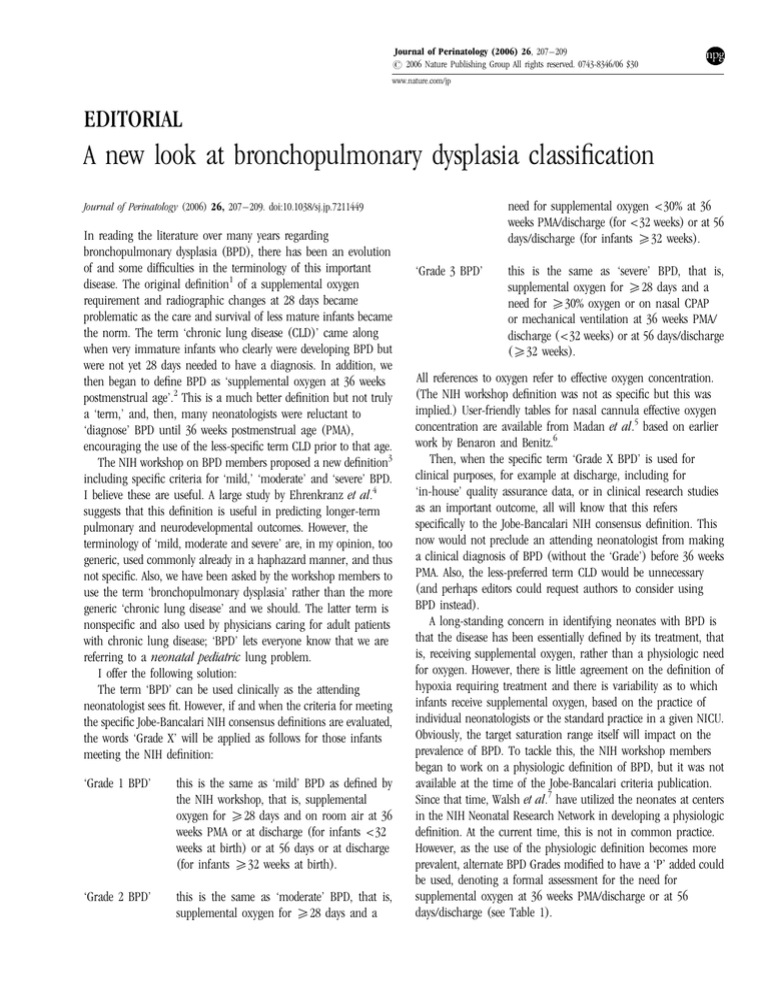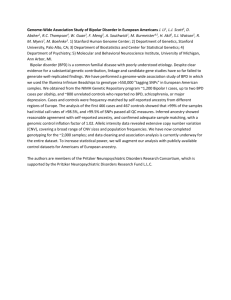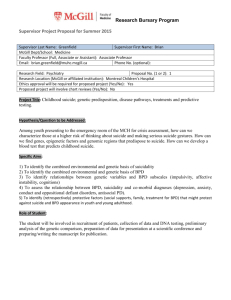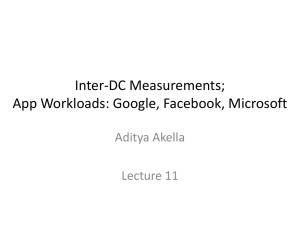
Journal of Perinatology (2006) 26, 207–209
r 2006 Nature Publishing Group All rights reserved. 0743-8346/06 $30
www.nature.com/jp
EDITORIAL
A new look at bronchopulmonary dysplasia classification
need for supplemental oxygen <30% at 36
weeks PMA/discharge (for <32 weeks) or at 56
days/discharge (for infants X32 weeks).
Journal of Perinatology (2006) 26, 207–209. doi:10.1038/sj.jp.7211449
In reading the literature over many years regarding
bronchopulmonary dysplasia (BPD), there has been an evolution
of and some difficulties in the terminology of this important
disease. The original definition1 of a supplemental oxygen
requirement and radiographic changes at 28 days became
problematic as the care and survival of less mature infants became
the norm. The term ‘chronic lung disease (CLD)’ came along
when very immature infants who clearly were developing BPD but
were not yet 28 days needed to have a diagnosis. In addition, we
then began to define BPD as ‘supplemental oxygen at 36 weeks
postmenstrual age’.2 This is a much better definition but not truly
a ‘term,’ and, then, many neonatologists were reluctant to
‘diagnose’ BPD until 36 weeks postmenstrual age (PMA),
encouraging the use of the less-specific term CLD prior to that age.
The NIH workshop on BPD members proposed a new definition3
including specific criteria for ‘mild,’ ‘moderate’ and ‘severe’ BPD.
I believe these are useful. A large study by Ehrenkranz et al.4
suggests that this definition is useful in predicting longer-term
pulmonary and neurodevelopmental outcomes. However, the
terminology of ‘mild, moderate and severe’ are, in my opinion, too
generic, used commonly already in a haphazard manner, and thus
not specific. Also, we have been asked by the workshop members to
use the term ‘bronchopulmonary dysplasia’ rather than the more
generic ‘chronic lung disease’ and we should. The latter term is
nonspecific and also used by physicians caring for adult patients
with chronic lung disease; ‘BPD’ lets everyone know that we are
referring to a neonatal pediatric lung problem.
I offer the following solution:
The term ‘BPD’ can be used clinically as the attending
neonatologist sees fit. However, if and when the criteria for meeting
the specific Jobe-Bancalari NIH consensus definitions are evaluated,
the words ‘Grade X’ will be applied as follows for those infants
meeting the NIH definition:
‘Grade 1 BPD’
this is the same as ‘mild’ BPD as defined by
the NIH workshop, that is, supplemental
oxygen for X28 days and on room air at 36
weeks PMA or at discharge (for infants <32
weeks at birth) or at 56 days or at discharge
(for infants X32 weeks at birth).
‘Grade 2 BPD’
this is the same as ‘moderate’ BPD, that is,
supplemental oxygen for X28 days and a
‘Grade 3 BPD’
this is the same as ‘severe’ BPD, that is,
supplemental oxygen for X28 days and a
need for X30% oxygen or on nasal CPAP
or mechanical ventilation at 36 weeks PMA/
discharge (<32 weeks) or at 56 days/discharge
(X32 weeks).
All references to oxygen refer to effective oxygen concentration.
(The NIH workshop definition was not as specific but this was
implied.) User-friendly tables for nasal cannula effective oxygen
concentration are available from Madan et al.5 based on earlier
work by Benaron and Benitz.6
Then, when the specific term ‘Grade X BPD’ is used for
clinical purposes, for example at discharge, including for
‘in-house’ quality assurance data, or in clinical research studies
as an important outcome, all will know that this refers
specifically to the Jobe-Bancalari NIH consensus definition. This
now would not preclude an attending neonatologist from making
a clinical diagnosis of BPD (without the ‘Grade’) before 36 weeks
PMA. Also, the less-preferred term CLD would be unnecessary
(and perhaps editors could request authors to consider using
BPD instead).
A long-standing concern in identifying neonates with BPD is
that the disease has been essentially defined by its treatment, that
is, receiving supplemental oxygen, rather than a physiologic need
for oxygen. However, there is little agreement on the definition of
hypoxia requiring treatment and there is variability as to which
infants receive supplemental oxygen, based on the practice of
individual neonatologists or the standard practice in a given NICU.
Obviously, the target saturation range itself will impact on the
prevalence of BPD. To tackle this, the NIH workshop members
began to work on a physiologic definition of BPD, but it was not
available at the time of the Jobe-Bancalari criteria publication.
Since that time, Walsh et al.7 have utilized the neonates at centers
in the NIH Neonatal Research Network in developing a physiologic
definition. At the current time, this is not in common practice.
However, as the use of the physiologic definition becomes more
prevalent, alternate BPD Grades modified to have a ‘P’ added could
be used, denoting a formal assessment for the need for
supplemental oxygen at 36 weeks PMA/discharge or at 56
days/discharge (see Table 1).
Editorial
208
Table 1 Bronchopulmonary dysplasia classification
Grade 1 BPD
Grade 2 BPD
Grade 3 BPD
Grade 1P BPD
Grade 2P BPD
Grade 3P BPD
Supplemental oxygen for X28 days and on room air at 36 weeks PMA or at discharge (for infants <32 weeks at birth) or at 56 days or at discharge
(for infants X32 weeks at birth), whichever comes first
Supplemental oxygen for X28 days and receiving supplemental effective oxygen <30% at 36 weeks PMA/discharge (<32 weeks) or at 56 days/
discharge (X32 weeks)
Supplemental oxygen for X28 days and receiving supplemental effective oxygen X30% oxygen or on nasal CPAP or mechanical ventilation at 36
weeks PMA/discharge (<32 weeks) or at 56 days/discharge (X32 weeks)
Supplemental oxygen for X28 days with documentation that saturations are X90% in room air at 36 weeks PMA/discharge (<32 weeks) or at 56
days/discharge (X32 weeks)
Supplemental oxygen for X28 days with a documented need for supplemental effective oxygen <30% based on failure to maintain oxygen
saturation X90% in a formal timed weaning trial at 36 weeks PMA/discharge (<32 weeks) or at 56 days/discharge (X32 weeks)
Supplemental oxygen for X28 days and on CPAP or mechanical ventilation or supplemental effective oxygen X30% based on failure to maintain
oxygen saturation X90% in a formal timed weaning trial at 36 weeks PMA/discharge (<32 weeks) or at 56 days/discharge (X32 weeks)
Modified from Jobe and Bancalari, Am J Respir Crit Care Med 2001; 163: 1723–1729.
‘P’ refers to use of the physiologic definition of BPD based on Walsh et al., Pediatrics 2004; 114: 1305–1311.
All references to oxygen refer to effective oxygen concentration delivered by hood or cannula (user-friendly tables available in Madan et al., Pediatrics 2005; 115: e450–e457 based
on Benaron and Benitz, Arch Pediatr Adolesc Med 1994; 148(3): 294–300).
The physiologic definition of BPD has focused on the overutilization of supplemental oxygen, by requiring a formal weaning
trial if oxygen saturations are ‘too high.’ This protects against
babies receiving oxygen who ‘may not need it,’ and a false
inflation of the prevalence of BPD in a given NICU. However,
somewhat less attention has been devoted to the opposite issue, that
is, that there may be babies in some units who are not receiving
oxygen who ‘should be’ and therefore a false ‘under-diagnosing’ of
BPD. This is not addressed directly by the NIH definition but is
addressed by Walsh et al.7 in that to have a diagnosis of ‘no BPD’
saturation must be X90% in room air. Also, the lower cutoff for
‘failing’ the trial of weaning was 90%; we infer then that these
NICUs did not routinely have infants at 36 weeks PMA with
saturations <90%. The cutoff of 90% was based on a survey of the
NICHD Neonatal Research Network members as there is little
rigorous data to determine the ‘best’ lower saturation target at this
age. The requirement of a saturation of X90% for room air
patients provides greater uniformity in categorizing babies not
receiving supplemental oxygen, rather than being based solely
on clinical discretion.
There is one remaining and unstudied issue in combining the
physiologic definition with the original NIH consensus definition.
In the studies by Walsh et al.7, the infants who were receiving
cannula/hood effective oxygen of X30% with saturation 90–96%
were not subjected to a timed weaning trial because it was felt
(logically) they would be unlikely to wean all the way to room air.
However, the goal of this work was to create a physiologic
definition of BPD based on a need for supplemental oxygen at 36
weeks PMA as a ‘yes/no’ categorization. For severity categorization,
the infant in X30% with saturations 90–96% may, in fact, be
weanable to <30%, which would alter the grade assigned. This will
need to be studied in the future but for the current classification
Journal of Perinatology
proposed, the requirement for a timed weaning trial will be for all
infants on cannula or hood oxygen. Ultimately, the timed weaning
trial may be obviated if consensus target saturations become
well-established and used widely.
Table 1 summarizes the classification system. Grades 1, 2 and 3
are based on oxygen treatment and the original NIH workshop
definition; Grades 1P, 2P and 3P are based on combining the NIH
consensus framework with the physiologic definition using oxygen
saturation requirements.
I am sure that many of the NIH workshop members worked very
hard examining and discussing data to develop these definitions
and it is important that they be used widely and consistently. A
more precise definition of BPD and its severity will be helpful in the
many necessary future clinical research studies.
Acknowledgments
I thank my colleagues Satyan Lakshminrusimha and Vasanth Kumar for their
valuable discussions regarding this editorial.
Rita M Ryan
Division of Neonatology, Department of Pediatrics,
State University of New York at Buffalo,
Women & Children’s Hospital of Buffalo,
Buffalo, NY, USA
E-mail: rryan@upa.chob.edu
References
1 Northway Jr WH, Rosan RC, Porter DY. Pulmonary disease following
respirator therapy of hyaline-membrane disease. Bronchopulmonary
dysplasia. N Engl J Med 1967; 276: 357–368.
Editorial
209
2 Shennan AT, Dunn MS, Ohlsson A, Lennox K, Hoskins EM. Abnormal
pulmonary outcomes in premature infants: prediction from oxygen
requirement in the neonatal period. Pediatrics 1988; 82(4): 527–532.
3 Jobe AH, Bancalari E. Bronchopulmonary dysplasia. Am J Respir Crit Care
Med 2001; 163(7): 1723–1729.
4 Ehrenkranz RA, Walsh MC, Vohr BR, Jobe AH, Wright LL, Fanaroff AA et al.
Validation of the National Institutes of Health Consensus definition of
Bronchopulmonary Dysplasia. Pediatrics 2005; 116(6): 1353–1360.
5 Madan A, Brozanski BS, Cole CH, Oden NL, Cohen G, Phelps DL et al. A
pulmonary score for assessing the severity of neonatal chronic lung disease.
Pediatrics 2005; 115(4): e450–e457.
6 Benaron DA, Benitz WE. Maximizing the stability of oxygen delivered via
nasal cannula. Arch Pediatr Adolesc Med 1994; 148(3): 294–300.
7 Walsh MC, Yao Q, Gettner P, Hale E, Collins M, Hensman A et al. Impact of
a physiologic definition on bronchopulmonary dysplasia rates. Pediatrics
2004; 114(5): 1305–1311.
Journal of Perinatology





